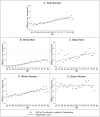Inter-Individual Variability in Trajectories of Functional Limitations by Race/Gender
- PMID: 30605552
- PMCID: PMC7357870
- DOI: 10.1093/geronb/gby156
Inter-Individual Variability in Trajectories of Functional Limitations by Race/Gender
Abstract
Objective: Several theories emphasize that systematic interindividual divergence is a key feature of cohort aging and evidence for accumulative social inequality over the life course. While many have documented widening health gaps with age between subgroups, such divergence is only one aspect of the broader social inequality based on race and gender. This article examines patterns of interindividual variability in trajectories of functional limitations within each race/gender.
Methods: Using data from the Health and Retirement Study (HRS)'s HRS cohort (born 1931-1941), I estimate growth curves of functional limitations with Level 2 heteroscedasticity, allowing interindividual variability to differ across 4 groups: white men, black men, white women, and black women. I examine race/gender differences in the age-based pattern of interindividual variability using an interquartile range of estimated individual trajectories.
Results: Black men, white women, and black women have greater interindividual variability in functional limitations than do white men. Interindividual variability increases systematically with age at similar rates for all groups but black women.
Discussion: Functional limitations become more heterogeneous with age for the entire cohort and for white men, white women, and black men. Future research should identify life-course processes that generate the race and gender patterning of interindividual variability in late-life health.
Keywords: Differential aging; Health inequalities; Heteroscedasticity.
© The Author(s) 2019. Published by Oxford University Press on behalf of The Gerontological Society of America. All rights reserved. For permissions, please e-mail: journals.permissions@oup.com.
Figures


References
-
- Alwin D., Hofer S., & McCammon R (2006). Modeling the effects of time. In Binstock R. & George L. (Eds.), Handbook of aging and the social sciences (6th ed., pp. 20–38). New York: Academic. doi:10.1016/b978-012088388-2/50005-5
-
- Bass S. A., Kutza E. A., & Torres-Gil F. M (1989). Diversity in aging. Glenview, IL: Foresman. doi:10.1017/s1041610292210978
-
- Brown T. H., Richardson L. J., Hargrove T. W., & Thomas C. S (2016). Using multiple-hierarchy stratification and life course approaches to understand health inequalities: The intersecting consequences of race, gender, SES, and age. Journal of Health and Social Behavior, 57, 200–222. doi:10.1177/0022146516645165 - PMC - PubMed
-
- Crystal S., & Shea D (1990). Cumulative advantage, cumulative disadvantage, and inequality among elderly people. The Gerontologist, 30, 437–443. doi:10.1093/geront/30.4.437 - PubMed

